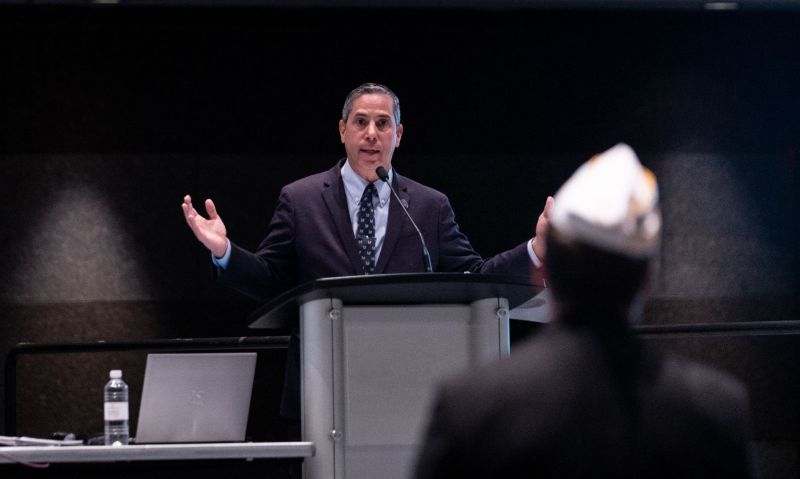
Chairman of VA’s Board of Veterans Appeals shares progress made via Appeals Modernization Act.
Legislation passed in 2017 to create a smoother, quicker appeals process for U.S. Department of Veterans Affairs benefits claims is starting fully take shape, based on the numbers shared with The American Legion Veterans Affairs & Rehabilitation Commission on Aug. 24 during the national convention in New Orleans.
Jaime Areizaga-Soto, chairman of VA’s Board of Veterans’ Appeals (BVA), shared with the commission that the board has surpassed 100,000 appeals adjudicated this year already and expects to surpass the year’s goal of 111,000. And equally important is the fact the Appeals Modernization Act (AMA) has surpassed legacy claims on the board’s docket for the first time this year. Legacy appeals are claims for which the VA provided notice of decision prior to implementation of the AMA and the claimant has not elected to participate in the AMA process.
“Why is this important?” Areizaga-Soto asked. “Because the AMA was adopted in 2017, we implemented in February of 2019, and here we are in 2024. It’s five years later. Nobody expected the AMA to come in five years later. But the fact is, with the law, we continue serving legacy and clear legacy inventory.
“I commend The American Legion and all the other groups for (supporting) AMA. The fact is, finally, AMA is now able to produce the way we all expected it to be. I’m really looking forward to 2025, where we take a direct target head on and meet the goals.”
While the number of legacy cases at the board continue to decrease, legacy, “is not completely out, but I feel it’s in the rearview mirror,” said Areizaga-Soto. “AMA is working. When you look at the grant percentages, they’re up. If you look at remands, they’re down.”
Areizaga-Soto also asked for assistance from the Legion and other veteran service organizations on one particular issue.
“Thirty-eight percent of the hearings that we schedule are either cancelled, withdrawn, no-shows or postponed every month,” he said. “That’s an area I like to point out to you so that we can all continue to work together. You can always let us know in advance. If it’s more than 30 days, it helps us a lot. This is an area where we continue to focus to reduce lost resources and capacity.”
VA Under Secretary for Benefits Joshua Jacobs noted that VA has seen “an increase in claim sharks trying to defraud veterans of their hard-earned benefits and give them false hope and false promise that if they just sign away 50 percent of their benefits, we’ll get you a quicker decision. We’ll get you a higher rating. That’s exactly not true and morally wrong. So, when we connect VSOs like The American Legion with those transitioning servicemembers, we can help get them connected with the right kind of help that they need to file their claims.”
Jacobs said that transitioning servicemembers who file their claims during the Benefits Delivery Discharge Program or within the first year of leaving the military, they have a higher grant rate. “I just want to say thank you to The American Legion for engaging the transitioning servicemembers across the country, and for providing feedback to make the process better.”
Jacobs also took time to thank the Legion for its efforts throughout the years in lobbying for continued improvements to the GI Bill, what he said has been referred to as, “the most consequential piece of legislation in our nation’s history. At its core, the GI Bill was the recognition that this country does not always get it right for veterans. But when we do make mistakes, we learn from them, and we constantly strive to do better. And this organization was at the center at advocating for and getting across the finish line the GI Bill.”
VA Under Secretary for Health Shereef Elnahal provided an update on how the passage of the PACT Act has impacted VA. Since the legislation was signed into law in August 2022, 740,000 new veterans have enrolled in VA health care.
“That represents a 33-percent increase from the two years before the PACT Act was signed,” Elnahal said. “We’ve had a massive increase in involvements. We’ve also upgraded 840,000 veterans from lower priority groups into Priority Groups 1 through 3 – the highest priority groups that ultimately confer more coverage for more services. “Our demand for care has skyrocketed.”
In Fiscal 2023, VA delivered a record 120 million health-care appointments – a number that VA is on pace to surpass this year.
“We knew that we had to staff up, because our most important asset in our organization is our people: our health-care workers, our physicians, our nurses, our food service workers, everybody who populates our hospitals and clinics,” Elnahal. “We had more than 61,000 almost in the first quarter, and then we hold every team accountable for increasing their productivity to see more veterans than they’ve ever seen before.”
Elnahal noted VA has reduced waits times for primary appointments by 8 percent, “All while seeing a record number of new vets.” He also pointed out that community is critical in meeting the higher demand, especially for veterans in rural areas. In Fiscal 2023, community care likely represented between 40 and 42 percent of all VA care.
“That really important partnership with private sector health care is absolutely necessary, especially for veterans who live in areas where we don’t have (VA providers),” Elnahal said. “From October through June of this year we saw a growth of 15.7 percent in referrals to the community. So, we’re growing direct care by appointment faster, but we still need massive increase in community care offerings because of what veterans need.”
- Convention

